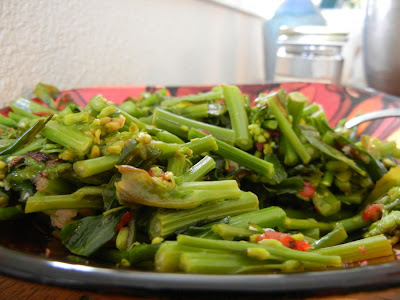Every lunch and dinner in Saint-Flour lasted about an hour and a half. Every single one included a first course, main course, vegetable dish, cheese course, dessert, and wine. The cheeses were always the same four. Nobody was ever completely sure what they were, but the most knowledgeable people told me they were Cantal, Saint-Nectaire, Fourme d'Ambert, and tomme de montagne. All of them were excellent. The soft cheeses had an amazing, gooey texture that I've never seen in American cheese. I attribute it to raw milk aged fewer than 60 days, or to non-refrigeration. We always had the same pretty good red table wine, even when we had white fish.
I tried to keep track of all of our meals and will record them for posterity here. I probably made a mistake or two, especially at the end.
- Monday:
- Lunchham and egg in aspic; braised beef, mashed potatoes; crème caramel
Dinnermelon; stewed Romano beans and other vegetables; breaded chicken cutlets; packaged coffee ice cream sundae - Tuesday
- Lunchquiche with Cantal cheese; stewed chicken with mushrooms, onions, and cauliflower; cooked peaches
Dinnerbeets and tomatoes in vinaigrette; salad, cod cakes (from yesterday's mashed potatoes); chocolate mousse - Wednesday
- Lunchprosciutto with bread and butter; pork chops with buttered pasta, roasted tomatoes; plum, apricot, and raspberry tart
Dinnersalad; chicken kebabs, string beans; fruit - Thursday
- Lunchtuna with mayonnaise; veal stew, scalloped potatoes; ice cream
Dinnergrapefruit; baked crepes with ham and béchamel sauce, endives, hash browns; baked apple with caramel - Friday
- Lunchsalad; a white fish called colin, which might be hake, in a very buttery sauce, rice with vegetables; meringue in vanilla sauce with caramel
Dinnercelery root remoulade; tomatoes stuffed with sausage; chopped vegetables; fruit - Saturday
- Lunchham/corned beef in aspic; steak, aligot (cheesy mashed potatoes); pastry with pears
Dinnersurimi (i.e., fake crab--seriously!); salad, lasagna; flan - Sunday
- Lunchassorted seafood (fish, mussels) baked in scallop shells with cheese on top; brussels sprouts with fried potato balls, chicken legs; tiramisu cake
Dinnermelon; croque monsieurs, salad; cooked peaches, lady fingers - Monday
- Lunchcarrots with vinaigrette; roast pork with prunes, french fries; packaged sundae with weird pear flavor
Dinnercured sausage with bread and butter; buckwheat crepes with cheese and mushrooms, stewed zucchini; banana, nuts, and chocolate with vanilla sauce - Tuesday
- Lunchmushrooms in sweet tomato sauce; rabbit stew with a cream sauce, egg noodles; tarte tatin
Dinnertomatoes with corn, crumbled boiled egg, and vinaigrette; spinach, potato croquettes, omelets with herbs; fruit - Wednesday
- Lunchbaloney-like meat; sausages, lentils; creme caramel
Dinnerbeans and vegetables in mayonnaise; quiche, salad; cake - Thursday
- Lunchbeets and cucumbers in vinaigrette; paella; strawberry cake
Dinnermelon; cold chicken, herbed potatoes; apricot Chantilly - Friday
- Lunchmixed vegetables; cheese and ham in pastry
Dinnerpaté de campagne; peas and carrots, breaded balls of ham and veal; chocolate pots de creme with ladyfingers



















































